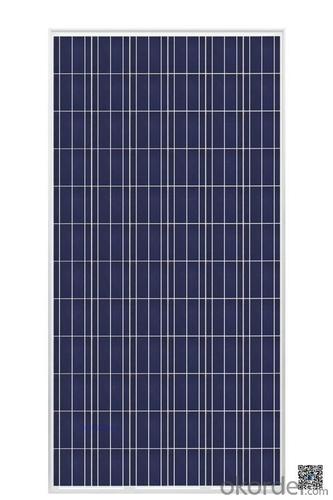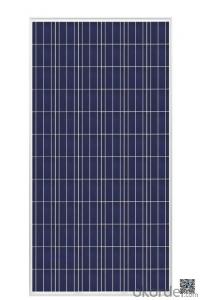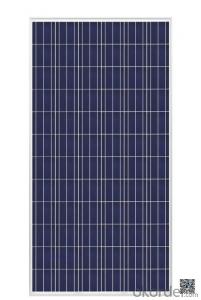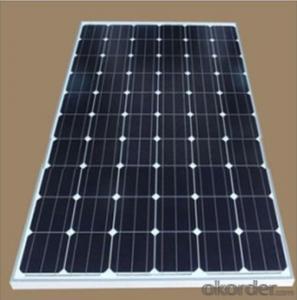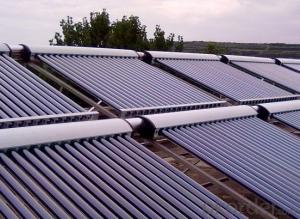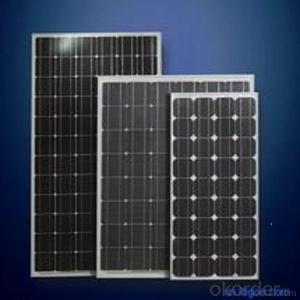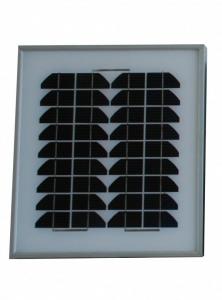Solar Panels for Heater - Solar Panel Poly in China, Solar Module Panel for Low Price
- Loading Port:
- Shanghai
- Payment Terms:
- TT OR LC
- Min Order Qty:
- 2500 watt
- Supply Capability:
- 26000 watt/month
OKorder Service Pledge
OKorder Financial Service
You Might Also Like
Specification
We now provide
• Monocrystalline Solar Panel
• Polycrystalline Solar Panel( multicrystalline silicon Solar Panel)
Features of our products:
Structure of Polycrystalline Silicon Solar Panel
Solar modules, which are widely used in ground mounted utility-scale PV plants, large-scale and small civil and commercial power generating system such as BIPV combined to the grid, roof-mounted PV power system, rural electrification, communications, emergency auxiliary power.
Solar PV module is comprised of some solar cells which are connected in serial with high efficiency and enhanced reliability.
Main Features of Polycrystalline Silicon Solar Panel
High wind-pressure and snow load, and easy installation
Water resistant junction box
Design to meet unique demand of customer
25 year poweroutput warranty
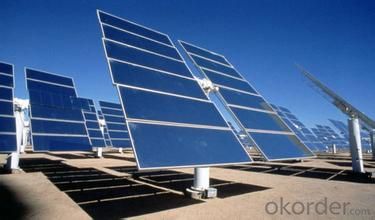
Polycrystalline Silicon Solar Modules 48Cell-195W Specification
ELECTRICAL PERFORMANCE | |||
Power output | P max | W | 195 |
Power output tolerances | ΔP max | W | 0/+5 |
Module effi ciency | η m | % | 14.7 |
Voltage at Pmax | V mpp | V | 23.7 |
Current at Pmax | I mpp | A | 8.03 |
Open-circuit voltage | V oc | V | 30.1 |
Short-circuit current | I sc | A | 8.65 |
Product Description:
This installation Manual contains essential information for the electrical and mechanical installation that your must know before installing CUSTOMER PV modules. This also contains safety information you need to be familiar with .All the information described in this manual are the intellectual property of CNBM and based on the technologies and experiences that have been acquired and accumulated in the long history of CUSTOMER. This document does not constitute a warranty, expressed or implied.
CUSTOMER does not assume responsibility and expressly disclaims liability for loss, damage, or expense arising out of in anyway connected with installation, operation, use or maintenance of the PV modules. No responsibility is assumed by CUSTOMER for any infringement of patents or other rights of third parties that may result from use of PV module.
CUSTOMER reserves the right to make changes to the product, specifications or installation manual without prior notice.
Solar panel working process
In addition to being the ultimate source of all life on earth, the sun is an infinitely renewable, completely pollution-free source of electricity. Instead of burning fossil fuels dug up from the ground in a big power plant – a very 19th century, industrial age approach, when you think about it – solar panels convert sunlight directly into electricity, with no harmful emissions.
The basic unit of a solar panel is a solar cell, which usually consists of one or two layers of silicon-based semiconductor wafers. When struck by the photons in sunlight, the solar cell generates an electrical charge due to the "photovoltaic effect" – which is a pretty good name, since it produces voltage from photons. The flow of these electrons moves in a steady electrical current from one side of the cell to the other.
Dozens of these PV cells are packaged together into solar modules, which in turn are packaged into solar panels that are mounted on a rooftop and arranged to maximize their hours of exposure to direct sunlight. Because the electricity generated by all those solar cells is direct current (DC), it is then sent to an inverter that transforms the power into the same alternating current (AC) used by the appliances in your home and the local utility electricity distribution grid. Increasingly, these inverters are getting "smart," providing data monitoring for solar installation performance and other grid integration services.
- Q: I need to power a series of meraki wireless repeaters that plug into a standerd wall outlet. consuming 5v or .08 amps However I need this in a remote location (like out in the middle of nowhere) Using A solar panel as power supply and a battery to store the energy but, how and what do I use to convert the energy coming from the solar panel to the battery and the batteries power supply to match the needs of the meraki wireless repeater? How do I make this as compact as possible? Do I need a ac/dc converter? or dc/ac converter? Any suggestions or solutions would be great !
- First things first. 5 Volts @ .08 amps would be .2 Watts. therefore you would need at least the same amount from a solar panel to replenish the batteries. But what puzzles me is the notion that plugging it in a wall outlet ? If you use 20 V @ 0.08 then the power consumption is 9.6 Watts And what is a meraki wireless repeater? I never heard of one. I'm a FCC licensed Ham and have some idea what is available. If you need 5 volts DC, you could use twelve Ni-cads in series and just keep them trickle charged with the solar panel That would make it compact. If you were to use an automotive battery (or motorcycle), then you would need a DC/DC converter.
- Q: solar panels or light parts
- They make lights that have solar panels built into them. Due to the solar cell, they can sense when it gets dark and thus switch on the light automatically. Look at Northern Tool or Harbor Freight web sites for ideas.
- Q: How much space do solar panels require?
- The space required for solar panels depends on several factors such as the power output of the panels and the efficiency of the solar cells. On average, a typical solar panel requires around 10-20 square feet of space. However, it is important to note that solar panels can be mounted on rooftops, installed in large solar farms, or even integrated into building materials, allowing for flexibility in their placement and utilization of available space.
- Q: So how does a solar panel work? Where does the energy get stored in? How much does one cost for a small 2 family home? How much money would we save on electricity?
- In the short, a solar panel is composed of many solar cells...all tied together and in some sort of a frame for mounting. When energy from the sun hits it, it creates a reaction which can feed electricity through leads to a converter system which takes the Direct Current power and converts it into Alternating Current. If you rewire your house for DC products I suppoes you wo'nt need the converter. but most of these systems are retro-fits. Batteries provide back up source to the system when the sun goes down. So solar is converted to electricity through the panel, which goes to your solar system which both provides power to the house and to recharge batteries. The batteries take over when the sun is down. So you will need to know how much battery capacity you need by calculating the Amp hour rating of your applicances that you normally use at night like Microwave, TV, radio, refrigerator, etc. For some depending on the appliance....water heater (if electric) or stove) then you need to figure out how many panels you need to provide your normal daily energy use, figure out how many batteries you need, set up a distribution system that gives you what you need where you want it and wa la. Once done, you will be off the grid and paying nothing from the electrical utility. Some places due to deregulations allow you to sell excess power to local utilities too, but those systems need to meet tight standards.
- Q: ok so when a solar panel is marked as a certain wattage dose that mean it makes that much in a day in an hour or constant, dose it still work at night or what ? is it worth it or is it more of a pain? can some one tell me what all the watts and volts mean ?? and can some one tell me what a kilowhat is in refrence to some thing i understand like howmany loads of laundey can you do wt a watt? i need help understanding this stuff?
- Quick okorder .
- Q: Can solar panels be used for charging electric scooters?
- Yes, solar panels can be used for charging electric scooters. By connecting the electric scooter to a solar panel system, the sunlight energy is converted into electricity, which charges the scooter's battery. This eco-friendly and sustainable method of charging can reduce reliance on grid electricity and promote renewable energy usage.
- Q: Can solar panels be installed on a military base or facility?
- Yes, solar panels can be installed on a military base or facility. In fact, many military bases have already implemented solar energy systems as part of their efforts to reduce reliance on traditional energy sources and promote sustainability. Solar panels can provide a reliable and cost-effective source of renewable energy to power various operations and facilities on military bases.
- Q: Could you have a solar panel in space that would transmit electricity remotely? Maybe have some kind of receiving antenna to pick up the energy? Perhaps there could be a string of them orbiting the Earth?Why wouldn't that work?
- Amazing how antique technology is so easily forgotten. Nikola Tesla first introduced the idea of wireless energy transmission in 89 and proved it by 899 in Colorado Springs, CO. He proved the Earth itself was a conductor of electricity. He also successfully conducted long-distance wireless energy transmission and reception. He wrote about the ability to wirelessly send electricity from a few central sources using longitudinal waves and magnetic flux all around the globe to be received at any point therefore electricity could be accepted by all uniformly. Although the means by which to do it was extremely far fetched, his theories are solid.
- Q: Are there different types of solar panels?
- Yes, there are different types of solar panels. The most commonly used types include monocrystalline, polycrystalline, and thin-film solar panels. Each type has its own advantages and disadvantages in terms of efficiency, cost, and appearance.
- Q: Are solar panels expensive?
- Solar panels can be expensive initially, but they are a long-term investment that can significantly reduce energy costs and provide a return on investment over time.
Send your message to us
Solar Panels for Heater - Solar Panel Poly in China, Solar Module Panel for Low Price
- Loading Port:
- Shanghai
- Payment Terms:
- TT OR LC
- Min Order Qty:
- 2500 watt
- Supply Capability:
- 26000 watt/month
OKorder Service Pledge
OKorder Financial Service
Similar products
Hot products
Hot Searches
Related keywords


